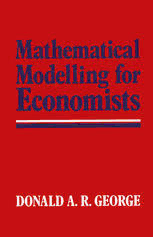
Mathematical Modelling for Economists PDF
Preview Mathematical Modelling for Economists
Mathematical Modelling for Economists Mathematical Modelling for Economists Donald A.R. George M MACMILLAN EDUCATION © Donald A.R. George 1988 All rights reserved. No reproduction, copy or transmissiOn of this publication may be made without written permission. No paragraph of this publication may be reproduced, copied or transmitted save with written permission or in accordance with the provisions of the Copyright Act 1956 (as amended), or under the terms of any licence permitting limited copying issued by the Copyright Licensing Agency, 33-4 Alfred Place, London WC1E 7DP. Any person who does any unauthorised act in relation to this publication may be liable to criminal prosecution and civil claims for damages. First published 1988 Published by MACMILLAN EDUCATION LTD Houndmills, Basingstoke, Hampshire RG212XS and London Companies and representatives throughout the world British Library Cataloguing in Publication Data George, Donald A.R. Mathematical modelling for economists. 1. Economics-Mathematical models I. Title 511' .8'02433 HB135 ISBN 978-0-333-42444-5 ISBN 978-1-349-19238-0 (eBook) DOI 10.1007/978-1-349-19238-0 To my mother and father Contents Preface ix 1 Models, theories and method 1 2 Calculus of several variables 9 Introduction Functions and inverse functions Continuity and derivatives Functions of several variables Maxima, minima and saddlepoints Convexity and concavity Partial and total derivatives 3 Kuhn-Tucker theory 35 Introduction Constrained maximisation and mm1m1sation Kuhn-Tucker methods An application of Kuhn-Tucker methods Multipliers as shadow prices Modelling the labour-managed firm 4 Linear programming 49 Introduction Primal and dual problems Duality theorems Another application Numerical methods of solution 5 Linear algebra 63 Introduction Simultaneous linear equations Eigenvalues and eigenvectors The open Leontief model Neo-Ricardian models 6 Differential equations 82 Introduction Single differential equations Two-dimensional linear dynamical systems Linear dynamical systems of higher dimension Linearisation Structural stability and robustness Rational expectations dynamics vii 7 Dynamic optimisation 113 Introduction The one-sector neoclassical growth model A more general maximand Pontryagin's maximum principle An example from the economics of resource depletion Rational expectations dynamics revisited The overtaking criterion 8 Discontinuities and catastrophes 135 Introduction A state-preference model with non-convexities Thorn's theorem A trade cycle model Methodological problems Appendix Brief solutions to selected exercises 159 Bibliography 165 Index 169 viii Contents Preface Model building is an activity which students often find difficult and sometimes rather puzzling. It can be difficult to see just how the latest 97-equation model with 35 parameters and 53 variables can have any relevance to the great problems of economics such as unemployment, poverty, distribution and growth. Students are frequently tempted to skip the 'nasty mathematical bit' in journal articles, and yet model building is an indispensable aspect of modern economics. The mathematics explained in this book is really quite easy but the process of model building requires skills other than simply knowing the appropriate mathematics. It is a process of abstrac tion involving the construction, manipulation and interpretation of models and this book places considerable emphasis on these issues. Modelling is thus treated as a fairly 'down-to-earth' pro cedure. We eschew the grand questions of the modern scholastics and the reader wishing to know how many equilibria can dance on a compact manifold will therefore have to look elsewhere. Having read the book, students should be able to understand the majority of models used in the general economics journals and even to construct and use simple models of their own. This book is based on courses given at Edinburgh and I am grateful to generations of Edinburgh students who never fail to offer comments and criticisms on the material with which they are presented. The book was revised while I was on leave at the European University Institute, Florence, to whom I am indebted for a generous Fellowship and an opportunity to work surrounded by Tuscan hills and endless supplies of Chianti. I am grateful also for the constructive and stimulating discussions I have had with colleagues both in Edinburgh and in Florence. I would mention in particular Simon Clark (Edinburgh) who read the entire manu script and provided much useful advice. I am also particularly grateful to Les Oxley (Edinburgh), who has permitted me to draw upon research we have conducted jointly, and to Robert Kast ix (Florence). Any remaining errors or omissions are, of course, my own. Chris Barton and Jessica Spataro, who can interpret Ice landic Runestones with ease, dealt swiftly with my dreadful hand writing, turning it efficiently into typescript; for this I am most grateful. Thanks also to Jennifer Pegg and Keith Povey for guiding the book through the editorial and production processes. Finally, my greatest debt is to my parents, for their unfailing support and encouragement in all my endeavours, including those even less reputable than textbook writing. Florence DONALD A.R. GEORGE x Preface 1 Models, theories and method Consider an Economics student presented with the following mathematical relationships: x =az+~ (1.1) q=q (1.2) z =x + y (1.3) w=x+q (1.4) w=z (1.5) and suppose he or she is told that equations (1.1)-(1.5) imply: dz 1 ---- (a of= 1) (1.6) dq 1-a He or she is probably not going to be particularly enlightened by this information. Suppose now that the variables in equations (1.1)-(1.5) are simply relabelled thus: C = aY + b (1.1') I =I (1.2') Y=C+S (1.3') E= C+I (1.4') E=Y (1.5') The familiar Keynesian-cross model of aggregate income determi nation is now self-evident and equation (1.6) yields the well known result relating the investment multiplier dY/dl to the marginal propensity to consume (a): dY 1 (1.6') di 1-a Equations (1.1)-(1.6) constitute a simple mathematical model of aggregate income determination. The model consists of a number 1
